Key Concepts - Socialism in Europe and the Russian Revolution | Social Studies (SST) Class 9 PDF Download
| Table of contents |

|
| The Age of Social Change |

|
| The Russian Revolution |

|
| October Revolution |

|
| Glossary and Important Information |

|
| Important Personalities |

|
| Important Dates and Events |

|
The Age of Social Change
The French Revolution opened up opportunities for significant changes in society. However, not everyone in Europe wanted such a complete overhaul. Some were ‘conservatives’, while others identified as ‘liberals’ or ‘radicals’.
Liberals
- Liberals sought a nation that accepted all religions. At that time, European states typically favoured one religion over others (for instance, Britain supported the Church of England, while Austria and Spain favoured the Catholic Church).
- They opposed the unchecked power of hereditary rulers and aimed to protect individual rights against government actions.
- Liberals advocated for a government elected by the people, governed by laws interpreted by an independent judiciary.
Radicals
- Radicals wanted a government that represented the majority of the population.
- They were against the concentration of wealth among a few individuals but did not oppose private property itself.
Conservatives
- They resisted change. After the revolution they started accepting change provided it was slow and had links and respected the past.
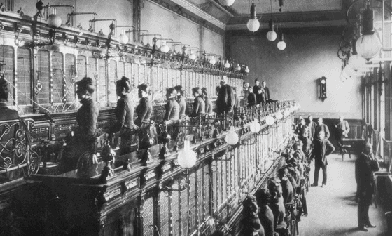 Industralization made a great social impact
Industralization made a great social impact
Industries and Social Change
- This period saw significant economic and social changes, with men, women, and children working in factories for low wages.
- Work hours were long, and pay was often insufficient, leading to common unemployment during downturns in demand for goods.
- Many liberals and radicals were property owners who believed workers deserved encouragement and support.
Socialism in Europe
- Socialists opposed private property, viewing it as the source of many social problems.
- They had various visions for the future; some supported cooperatives, while others insisted that governments should promote these cooperatives.
- Karl Marx and Friedrich Engels described industrial society as capitalist, with Marx arguing that a socialist society would liberate workers from capitalism, leading to a communist society.
Socialism Given Support
- Workers in Germany and England began forming associations to improve their living conditions.
- They established funds to assist members in distress and demanded shorter working hours and voting rights.
- To unify their efforts, socialists created an international organisation called the Second International.
The Russian Revolution
In 1914, Tsar Nicholas II ruled the Russian empire, which included present-day Finland, Latvia, Lithuania, Estonia, parts of Poland, Ukraine, and Belarus. The main religion was Russian Orthodox Christianity, which had developed from the Greek Orthodox Church. However, the empire was also home to Catholics, Protestants, Muslims, and Buddhists.
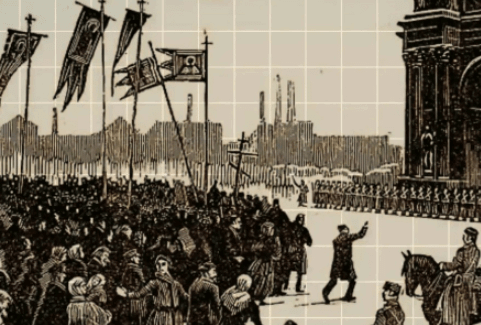 Socialism in Russian Revolution
Socialism in Russian Revolution
Economy and Society
- Most people in Russia were farmers.
- Industries were starting up, mostly owned by private industrialists.
- Workers sometimes joined together to strike when they disagreed with their employers over job dismissals or working conditions.
- Russian peasants wanted the land owned by nobles and often refused to pay rent, differing from the respect shown by French peasants during their revolution.
- Russian peasants uniquely pooled their land, dividing it according to the needs of families.
Socialism in Russia
- While it is partly true that all political parties were illegal before 1914, the Russian Socialist Democratic Labour Party was founded in 1900, showing that some political activity existed, albeit suppressed.
- This party split into the Bolsheviks and Mensheviks.
- Lenin believed that peasants were not a single social group and thought workers would lead the revolution.
The 1905 Revolution
- Russia was an autocracy, meaning the Tsar was not accountable to parliament.
- Liberals aimed to change this and sought a constitution during the 1905 Revolution.
- A procession was brutally attacked by police and Cossacks, resulting in over 100 workers being killed.
- This led to strikes and demands for a constituent assembly.
- The Tsar permitted an elected consultative Parliament called the Duma, but he dismissed the first Duma within 75 days and the second Duma after three months.
Bloody Sunday
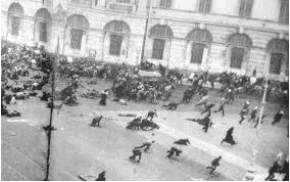 Bloody Sunday
Bloody Sunday
- Prices of essential goods rose so quickly by 1904 that the real wages declined by 20%. During this time, four members of the Putilov Iron Works were dismissed. Action was called for. Over 110,000 workers in St. Petersburg went on strike demanding a reduction in working hours and increase in wages.
- This procession was attacked by the police and Cossacks. Over 100 workers were killed. Strikes took place as a reaction. People demanded a constituent assembly. The Tsar allowed the creation of an elected consultative Parliament or Duma. The Tsar dismissed the first Duma within 75 days and announced the election of a second Duma.
The First World War and the Russian Empire
- Initially, the war was quite popular in Russia, but support declined over time.
- Russian armies suffered significant defeats against Germany and Austria.
- There were 7 million casualties and 3 million refugees in Russia.
- The war also disrupted industry, causing a shortage of labour, closure of railway lines, and shutting down of small workshops.
- Bread and flour became increasingly scarce.
The February Revolution in PetrogradEvents
- During the winter of 1917, conditions in Petrograd, the capital, were very harsh. The city’s layout highlighted the differences between its residents. Workers lived and worked on the right bank of the River Neva, while the left bank housed the wealthy, the Winter Palace, and important government buildings, including the Duma. Food shortages hit the workers' areas hard, and the winter was exceptionally cold with heavy snowfall.
- 22 February: a lockout occurred at a factory on the right bank. Women played a leading role in the strikes, which became known as International Women’s Day. The following day, workers from fifty factories joined in a sympathy strike.
- The government imposed a curfew as workers surrounded the fashionable district and government buildings. Although demonstrators dispersed by the evening, they returned on the 24th and 25th.
- On Sunday, 25 February, the government suspended the Duma. Politicians opposed this decision, and the people protested vigorously again.
- On 27th, the police headquarters were attacked.
- The government deployed cavalry and police to monitor the situation, and the cavalry was sent out once more.
- At a regiment's barracks, an officer was shot, leading three other regiments to mutiny and decide to support the striking workers. The striking workers gathered to form a 'soviet' or 'council' in the same building where the Duma met, known as the Petrograd Soviet.
- A delegation was sent to meet the Tsar, and military leaders advised him to abdicate.
- The Tsar abdicated on 2nd March.
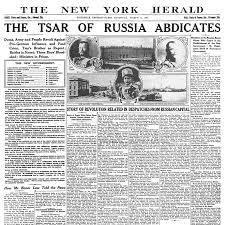
- An officer was shot at the barracks of a regiment and other regiments mutinied, voting to join the striking workers gathered to form a soviet or council. This was the Petrograd Soviet.
- A delegation went to meet the Tsar, military commanders advised him to abdicate.
- The Tsar abdicated on 2nd March.
- A Provincial Government was formed by the Soviet and Duma leaders to run the country.
- The people involved were the parliamentarians, workers, women workers, soldiers and military commanders.
Effects
- Restrictions on public meetings and associations were lifted.
- 'Soviets', such as the Petrograd Soviet, were established widely, although no standard election process was adhered to.
- In some regions, factory committees emerged, challenging how industrialists managed their factories.
- Soldiers’ committees were created within the army.
- As the Provisional Government's power diminished and Bolshevik influence increased, it chose to implement strict measures against the growing unrest.
- It opposed efforts by workers to manage factories and began arresting their leaders.
- Peasants and their Socialist Revolutionary leaders called for land redistribution. Land committees were set up for this purpose, and peasants occupied land between July and September 1917.
- Public demonstrations organised by the Bolsheviks in July 1917 were harshly suppressed.
October Revolution
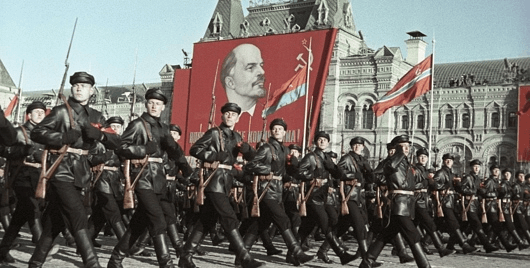 Significance of October revolution
Significance of October revolution
16th October 1917 — Lenin persuaded the Petrograd Soviet and Bolshevik Party to agree to a socialist seizure of power. A Military Revolutionary Committee was appointed by the Soviet to organise seizure.
- Uprising began on 24th October. Prime Minister Kerenskii left the city to summon troops.
- Military men loyal to the government seized the buildings of two Bolshevik newspapers. Pro-government troops were sent to take over telephone and telegraph offices and protect the Winter Palace.
- In response Military Revolutionary Committee ordered to seize government offices and arrest the ministers.
- The ‘Aurora’ ship shelled the Winter Palace. Other ships took over strategic points.
- By night the city had been taken over and ministers had surrendered.
- All Russian Congress of Soviets in Petrograd approved the Bolshevik action.
- Heavy fighting in Moscow — by December, the Bolsheviks controlled the Moscow - Petrograd area.
- The people involved were Lenin, the Bolsheviks, troops (pro-rgovenment).
Effects
- Most industry and banks were nationalised in November 1917.
- Land was declared social property and peasants were allowed to seize the land of the nobility.
- Use of old titles was banned.
- New uniforms were designed for the army and officials.
- Russia became a one party state.
- Trade unions were kept under party control.
- A process of centralised planning was introduced. This led to economic growth.
- Industrial production increased.
- An extended schooling system developed.
- Collectivisation of farms started.
Glossary and Important Information
1. Tsar: Title given to the emperor of Russia which was abolished in 1917.
2. Romanov: Name of the dynasty which ruled Russia in 1917.
3. Communism: An economic system in which the means of production are owned by the state.
4. Bolsheviks: The majority group of the Russian Social Democratic Labour Party led by Lenin based on the ideology of Marx and Engels.  Bolsheviks at a meeting5. Soviet Union: The union of Soviet Socialist Republic (U.S.S.R) formed after the overthrow of the Tsarist Empire.
Bolsheviks at a meeting5. Soviet Union: The union of Soviet Socialist Republic (U.S.S.R) formed after the overthrow of the Tsarist Empire.
6. Bloody Sunday: A mass of peaceful workers led by Father Gabon were fired upon by the Russian troops when they went to the Winter Palace to present a petition to the Tsar. Heavy casualties ensued. This incident which occurred on Sunday 22nd January, 1905 is known as Bloody Sunday.
7. Council of People’s Commission: The council of representatives of people to whom power was transferred after the Russian Revolution. It was headed by Lenin.
8. Duma: 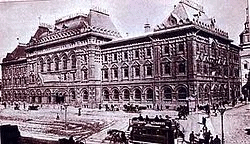 Duma's outside viewThe Russian parliament or legislature. Its members were elected and charged with the responsibility of making laws.
Duma's outside viewThe Russian parliament or legislature. Its members were elected and charged with the responsibility of making laws.
9. Divine Right Theory: The theory which believed that the king was the representative of God on earth and no one has the right to defy him. This theory was held by the Russian Tsar to perpetuate their autocratic rule.
10. Mensheviks: The minority group of the Russian Social Democratic Labour Party formed in 1898. They favoured a government of the type that existed in countries like France and Germany.
11. Nationalisation: To bring under government control.
12. Red Army : The army of Revolutionary Russia which fought against the Tsar’s army. It was composed mainly of workers and peasants.
13. Revolution of 1917: It refers to the events of November 1917. Control was in the hands of the All Russian Congress of Soviets. The Kerenskii’s government was overthrown.
14. Serfdom: Russian type of feudalism under which peasants worked for the landlord in exchange for food and shelter. No wages were paid.
15. Soviet: Council of workers.
16. Suffragette: A movement to give women the right to vote.
17. Jadidists: Muslim reformers within the Russian empire.
18. Autonomy: The right to govern themselves.
19. Deported: Forcibly removed from one’s own country.
20. Exiled: Forced to live away from one’s own country.
21. Collective Farms: A large farm owned by the government and worked by hundreds of workers.
22. Requisition: When the government forcibly takes food or property from people, usually in wartime.
23. Kulaks: Wealthy peasants or farmers.
24. War Communism: The policy of the Russian government from mid- 1918 to 1921 was known as war communism. It was not one particular law or decree, but a whole series of measures designed to take control of the economy.
25. New Economic Policy: Introduced in 1921, it made important changes in the way the Soviet economy was organised.
26. Comintern: The Communist international is the organisation set up by Lenin to sponsor communist revolutions all over the world.
Important Personalities
1. Lenin: 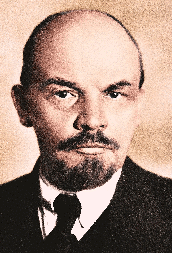 LeninThe leader of the Bolshevik Party who led the Russian Revolution in 1917. As a result of the Treaty of Brest-Litovsk with Germany, he withdrew Russia from the First World War and took various measures to make Russia a socialist state.
LeninThe leader of the Bolshevik Party who led the Russian Revolution in 1917. As a result of the Treaty of Brest-Litovsk with Germany, he withdrew Russia from the First World War and took various measures to make Russia a socialist state.
2. Nicholas II: The Tsar of Russia whose Policies precipitated the Russian Revolution.
3. Kerenskii: He leader of the Mensheviks party who wanted to establish a parliamentary form of government in Russia.
4. Leon Trotsky: He headed the Petrograd Soviet and played a leading role in the Russian Revolution and was later assassinated by Stalin.
5. Rasputin: An unscrupulous monk whose influence over the royal family was resented by the Russian people.
6. Engels: Frederick Engels in association with Karl Marx published the Communist Manifesto that was the guiding spirit of the Russian Revolution.
7. Rosa Luxemburg and Karl Liebknecht: Leaders of the German revolutionary movement, they tried a revolution in 1919. But the army crushed the revolution. Both were captured and shot.
8. Joseph Stalin: He emerged as the leader of the Communist Party after the death of Lenin in 1924. He assumed complete control of Russian government and its policies till his death in 1953.
Important Dates and Events
- 1861: The Tsar abolished Serfdom.
- 1898: Formation of the Russian Social Democratic Workers Party.
- 1905: The Bloody Sunday and the Revolution of 1905.
- 1917:
- 2nd March - Abdication of the Tsar.
- 24th October - Bolshevik uprising in Petrograd.
- 1918-20: The Civil War.
- 1919: Formation of Comintern.
- 1929: Beginning of Collectivisation.
|
55 videos|525 docs|78 tests
|
FAQs on Key Concepts - Socialism in Europe and the Russian Revolution - Social Studies (SST) Class 9
| 1. What was the Russian Revolution? |  |
| 2. What were the causes of the February Revolution in Petrograd? |  |
| 3. What was the significance of the October Revolution? |  |
| 4. What were the effects of the Russian Revolution? |  |
| 5. Who were some important personalities associated with the Russian Revolution? |  |
















